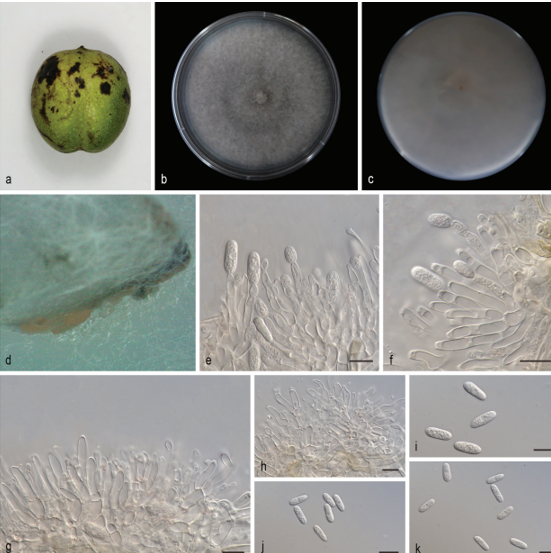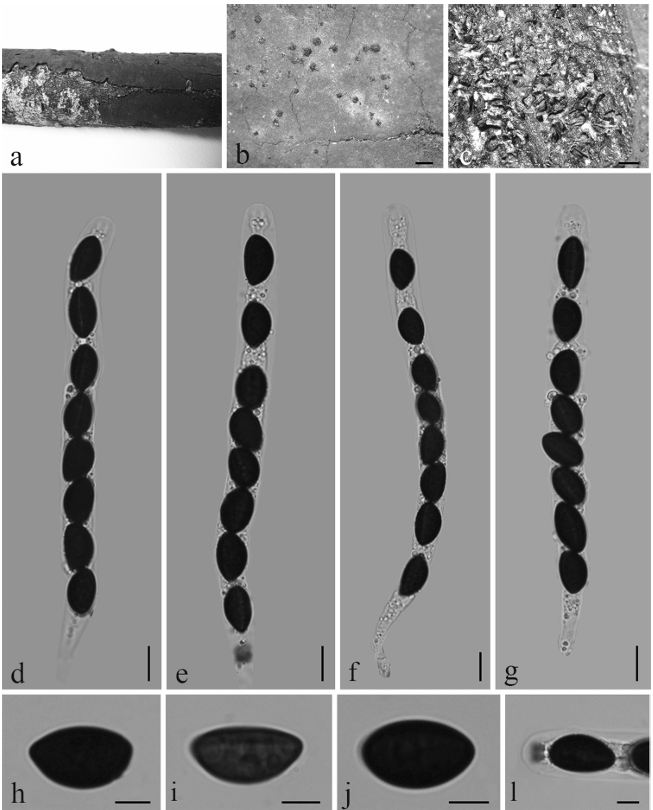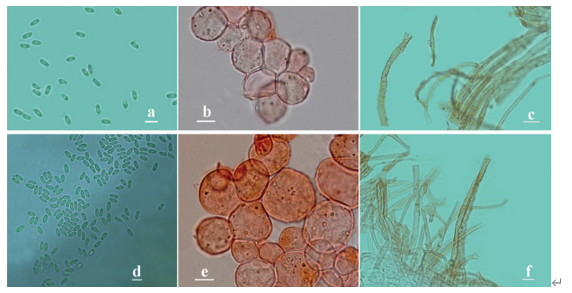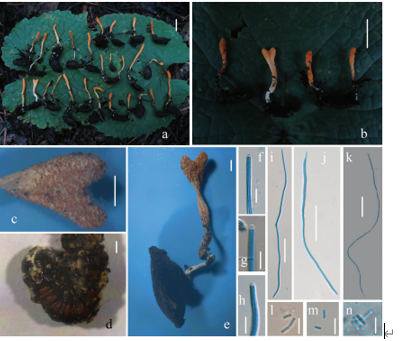Anisomeridium guangdongensis S.H. Jiang & C. Zhang, sp. nov. 2020
MycoBank MB 833651
Holotype: CHINA. Guangdong: Huizhou City, Xiangtoushan National Nature Reserve. 180 m elev., 23°20′28′′ N, 114°23′56′′ E, on bark of trees, 18 March 2019, S.H. Jiang & C. Zhang 20190658 (Holotype, HMAS–L 0143783)
Morphological description
hallus crustose, corticolous, continuous, partly marginally dispersed, pale greenish white to pale gray or slightly cream-coloured, 50–80 µm thick, dull, minutely roughened, lacking a distinct cortex, surrounded by a black prothallus line, UV+ pale yellow, K+ yellow. Photobiont trentepohlia, cells globose, 6–9 × 4.5–5.5 µm, yellowish green. Ascomata perithecioid, hemispherical to conical, 0.07–0.12 mm diam., solitary, occasionally paired or in clusters of 3 or 4, erumpent to prominent, dull, uneven, usually carbonized, black but sometimes covered by thallus, apex convex or plane. Ostiole apical, round, black, often indistinct, 8–12 µm diam. Ascomatal wall 40–150 µm thick, brown-black to black, extending down to excipulum-base level, continuous with the excipulum or diverging a little at the base, not overgrown by the thallus, uneven. Excipulum 20–30 µm thick, pale brown to dark brown. Hymenium about 130–150 μm high, and 175‒200 μm wide. Subhymenium 20–30 μm thick, concave above. Pseudoparaphyses 1–1.5 µm wide, long-celled, branched and anastomosing to form a network above the asci. Asci with inconspicuous ocular chamber, broadly clavate, narrowly or broadly cylindrical, 55–65 × 10–14 µm. Ascospores 8 per ascus, biseriate, colourless, broadly ellipsoid or oblong-ellipsoid, 1-septate, upper cell larger than the lower, not constricted near the septum, straight or slightly bent, distal apex rounded, a part of the ascospores are ornamented with small warts, 16–20 × 6–8 µm. Conidiomata not seen.
Habitat: on bark of trees.
Distribution: the type locality.
GenBank Accession:
Notes: the new species, Anisomeridium guangdongensis, is characterized by the pale greenish white thallus with lichexanthone (UV+ pale yellow), small perithecia, thick ascomatal wall, and oblong-ellipsoid, 1-septate ascospores, with the upper cell larger than the lower. It is somewhat similar to A. tuckerae r.C. Harris (1980: 83) and A. albidoatrum (Nyl.) r.C. Harris (1995). But the ascospores of A. tuckerae and A. albidoatrum are different: fusiform, 15‒20 × 5‒6 μm in A. tuckerae (Tucker & Harris 1980); narrowly fusiform, 14‒19 × 4‒5.5 μm in A. albidoatrum (Harris 1995). regarding ascospores, A. austroaustraliense P.M. McCarthy & Kantvilas (2016: 16) and A. calcicola Upreti & Nayaka (2006: 231) also resemble the new species. However, the ascomatal wall of A. austroaustraliense is thinner (25–70 µm) (McCarthy & Kantvilas 2016); A. calcicola grows on calcareous rocks and usually has larger perithecia (0.25–0.50 mm diam.) (Upreti & Nayaka 2006). Another similar species is A. anisolobum (Müll. Arg.) Aptroot (1995: 57), which can be distinguished by a UV- thallus and larger ascospores (18–22 × 10–13 μm) (Aptroot et al. 1995).
Reference: CHAO ZHANG1,2,4, ANdrÉ APtrOOt3,5, HUA-JIE LIU2,6* et al.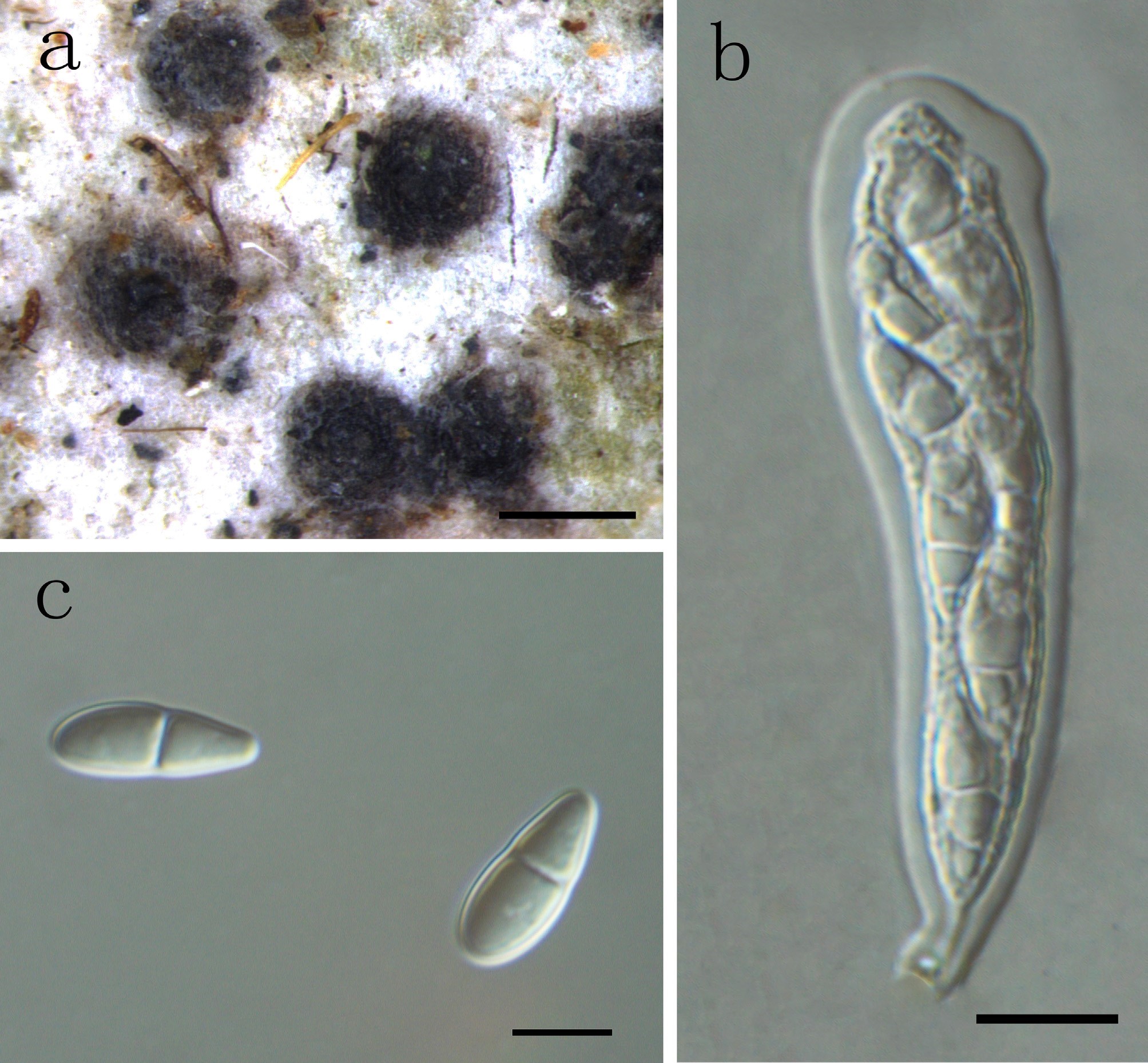
the new species Anisomeridium guangdongensis (holotype, HMAS–L 0143783). a thallus with ascomata; b Ascus with 8 ascospores; c Ascospores. Scale bars: a=100 µm; b, c=10 µm.


